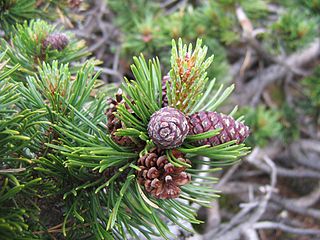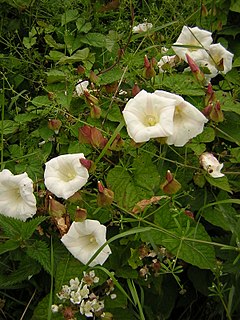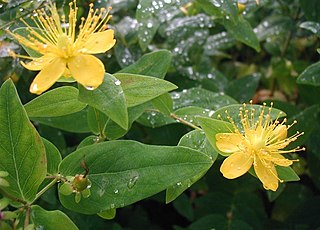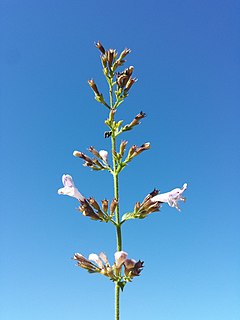
Acer campestre, known as the field maple, is a flowering plant species in the family Sapindaceae. It is native to much of continental Europe, Britain, southwest Asia from Turkey to the Caucasus, and north Africa in the Atlas Mountains. It has been widely planted, and is introduced outside its native range in Europe and areas of USA and Western Australia with suitable climate.

Pinus mugo, known as bog pine, creeping pine, dwarf mountain pine, mugo pine, mountain pine, scrub mountain pine, or Swiss mountain pine, is a species of conifer, native to high elevation habitats from southwestern to Central Europe and Southeast Europe.

Ulex is a genus of flowering plants in the family Fabaceae. The genus comprises about 20 species of thorny evergreen shrubs in the subfamily Faboideae of the pea family Fabaceae. The species are native to parts of western Europe and northwest Africa, with the majority of species in Iberia.

Lotus corniculatus is a flowering plant in the pea family Fabaceae, native to grasslands in temperate Eurasia and North Africa. Common names include common bird's-foot trefoil, eggs and bacon, birdsfoot deervetch, and just bird's-foot trefoil, though the latter name is often also applied to other members of the genus.

Molinia caerulea, known by the common name purple moor-grass, is a species of grass that is native to Europe, west Asia, and north Africa. It grows in locations from the lowlands up to 2,300 m (7,546 ft) in the Alps. Like most grasses, it grows best in acid soils, ideally pH values of between 3.5 and 5, however, it can continue to live under more extreme conditions, sometimes to as low as 2. It is common on moist heathland, bogs and moorland throughout Britain and Ireland. Introduced populations exist in northeastern and northwestern North America.

Calystegia sepium is a species of flowering plant in the family Convolvulaceae. It has a subcosmopolitan distribution throughout temperate regions of the North and South hemispheres.

Helianthemum nummularium is a species of rock-rose (Cistaceae), native to most of Europe.

Amaranthus deflexus is also known by the common names low amaranth, Argentina amaranth, perennial pigweed, and large-fruit amaranth. It is native to South America, and has been introduced to many other parts of the world. It is a short-lived perennial or annual plant. The plant can grow up to 1.5 ft in height.

Prunella grandiflora, the large-flowered selfheal, is a species of flowering plant in the family Lamiaceae. It is native to Europe and neighboring parts of West Asia.

The morning glory Calystegia silvatica is known by the common name giant bindweed or large bindweed. It is the largest species of bindweed and is a strong rampant climber.

Coreopsis grandiflora is a North American species of perennial plant in the family Asteraceae. The common name is large-flowered tickseed. It is found in eastern Canada and much of the United States, especially the south-central part of the country. The species is widely cultivated in China and naturalized there.

Artemisia campestris is a common and widespread species of plants in the sunflower family, Asteraceae. It is native to a wide region of Eurasia and North America. Common names include field wormwood, beach wormwood, northern wormwood, Breckland wormwood, boreal wormwood, Canadian wormwood, field sagewort and field mugwort.

Erodium cygnorum is a species of herb native to Australia.

Thelypteris palustris, the marsh fern, or eastern marsh fern, is a species of fern native to eastern North America and across Eurasia. It prefers to grow in marshy situations in full sun. The species epithet palustris is Latin for "of the marsh" and indicates its common habitat. It is the only known host plant for Fagitana littera, the marsh fern moth.

Silene uniflora is a species of flowering plant in the family Caryophyllaceae known by the common name sea campion.

Arabis caucasica is a species of flowering plant in the mustard family (Brassicaceae) known by the common names garden arabis, mountain rock cress or Caucasian rockcress.

Hypericum hircinum, also known as stinking tutsan, is a shrubby flowering plant in the St. John's wort family Hypericaceae.

Chaenorhinum minus, also known as small toadflax in Europe and dwarf snapdragon in the US and Canada, is a very diminutive member of the plant family Plantaginaceae. It is native to continental Europe.

Clinopodium menthifolium, commonly known as the wood calamint or woodland calamint, is a species of flowering plant in the mint family, Lamiaceae. It is found throughout southern and central Europe from the United Kingdom and east as far as temperate parts of Asia, and as south as North Africa. It grows up to 1,700 m (5,600 ft) in elevation.



















